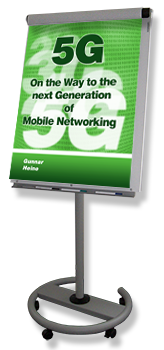 5G - On the Way to the next Generation of Mobile Networking
5G - On the Way to the next Generation of Mobile Networking
[2-day course, Euro 2,350.- (net) per participant]
 Training Course Description
Training Course Description
- This course addresses the needs of technical engineering staff who require a thorough understanding of the evolution of the cellular and mobile networking technology towards 5G.
- The course has been designed to meet the requirements of operations, engineering and product management staff. It also targets technically encouraged marketing people, who require detailed knowledge about the upcoming 5G technologies.
- The course starts with a description of the envisaged timeline for 5G and the involved players. This part continues with an introduction of the technologies which enable 5G, namely filtered OFDM (5G NR) and the new architecture, namely the gNB-CU and gNB-CU and the NGC.
- We introduce the so-called functional split and depict the different options.
- The first chapter ends with a description of potential migration from 4G to 5G and the intermediate deployment options, the co-called NSA (Non Stand Alone).
- The next chapter is dedicated to the requirements and performance targets for 5G, coming from different organizations like the ITU-R or 3GPP themselves.
- 5G introduces new business options to the cellular domain, namely URLLC and an emphasized meaning of the IoT. However, we also look at the new understanding of the so-called eMBB.
- The following part of the course is dedicated to an overview of the current developments in the WiFi-market and the chances, competition and risks of and between the two technologies, WiFi and cellular.
- The description of 5G related deployment scenarios like dense urban, highspeed train or indoor hotspot completes this part of the course.
- The next chapter is dedicated to a deeper analysis of the envisaged first phases of the new PHY with 5G. This relates in particular to filtered OFDMA and its numerology. We elaborate the numerologies from 15 kHZ to 480 kHz in detail and present the most likely use cases, frequency bands, carrier bandwidths etc..
- One level above we present the new forward error correction techniques polar coding and LDPC and compare them with turbo coding and convolutional coding.
- The next chapter is dedicated to the 5G-network architecture which is largely driven by virtualization to reduce latency, time-to-market and cost and to increase flexibility and new business opportunities (Xaas). This part contains a practical example of virtualization plus an introduction into SDN and OpenFlow.
- The architecture related chapter also contains a detailed description of the different options of the functional split inside the NG-RAN and presents how eCPRI can be used to realize the functional split towards an RRH.
- We point out, how dual connectivity and different bearer types like MCG-, SCG- and split bearers can be used for the intermediate implementation of NSA.
- The NGC (Next Generation Core) with its different network functions is presented and how these network functions can be related to network elements.
- The final chapter depicts other interesting aspects of 5G, some which may be shifted to 5G phase 2, others which will be implemented earlier.
This relates to an understanding of “self-contained TDD” which enables much smaller RTT’s than in legacy TDD. - We also introduce the operation and characteristics of NOMA and how it operates through superposition coding and filtering.
- As a “wrap-up”, we look at the most likely options how WiFi may complement 5G most efficiently and most likely from the perspective of the market.

Some of your questions that will be answered
- How can 5G technically achieve an internal latency of 1ms and lower?
- What does functional split mean and which options exist?
- What are the benchmarks of a 5G cellular standard with respect to throughput rate, latency and spectral efficiency?
- On which bands will 5G operate?
- What are the differences between CPRI and eCPRI and how will eCPRI be used in 5G?
- How does the network architecture of a 5G cellular network look like?
- What are the so-called numerologies of the 5G PHY and how does F-OFDM work?
- How will 5G be initially deployed? How does this relate to NSA (Non-Stand Alone) operation?
- What is a mini-slot and how long is the TTI in 5G?
- Why do LDPC and polar coding replace turbo coding and convolutional coding?
- What is the channel structure in 5G and which new channels does 5G introduce?
- How does WiFi blend into the cellular evolution, esp. with 802.11ax?
- Which new business areas does a 5G cellular standard address, e.g. online gaming and URLLC?
- What is the structure of the NGC (Next Generation Core) and how does this relate to virtualization?
- How does network slicing work and how is it implemented in 5G?
- What is NOMA and how does it work?
- Why is the 5G base station, the gNB, split into a CU (Centralized Unit) and a DU (Distributed Unit)?
- Can TDD meet the stringent latency requirements of 5G?
- What is “self-contained” TDD and how does it operate?
 Pre-Requisites
Pre-Requisites
- The students should have detailed knowledge of preceding cellular technical standards, namely 4G / LTE but preferably also on 2G / GSM+GPRS and 3G / UMTS+HSPA.
- The students need to be technically focused, especially if they are product managers or are coming from marketing and sales.
 Training Course Target
Training Course Target
- The students will understand the upcoming technical and business related changes to be expected with 5G.
- The students can link vendor related marketing information to non-vendor specific 5G requirements.
- Students are enabled to engineer and plan upcoming 5G-networks.
 Training Course Duration
Training Course Duration
- 2 days
v1.000
ℹ️ Try out the updated search below!
Search:
More Info:
Detailed ToC of this training course
Schedule of this training course
INACON eBooks
Please have a look at our full offer

